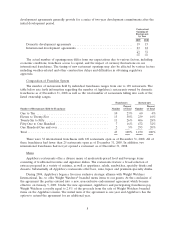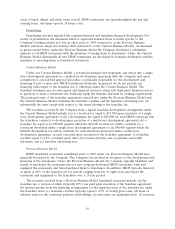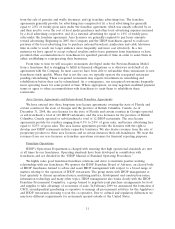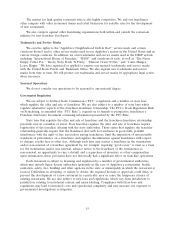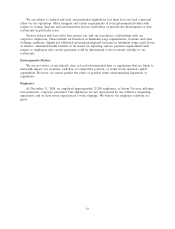IHOP 2008 Annual Report Download - page 20
Download and view the complete annual report
Please find page 20 of the 2008 IHOP annual report below. You can navigate through the pages in the report by either clicking on the pages listed below, or by using the keyword search tool below to find specific information within the annual report.
franchisees operated 128 Applebee’s restaurants. During 2008, 20 new international franchise
restaurants were opened while three international franchise restaurants were closed. The success of
further international expansion will depend on, among other things, local acceptance of the Applebee’s
concept and menu offerings and our ability to attract qualified franchisees and operating personnel.
Our franchisees must comply with the regulatory requirements of the local jurisdictions.
We work closely with our international franchisees to develop and implement the Applebee’s
system outside the United States, recognizing commercial, cultural and dietary diversity. Differences in
tastes and cultural norms and standards mean we need to be flexible and pragmatic regarding many
elements of the Applebee’s system, including menu, restaurant design, restaurant operations, training,
marketing, purchasing and financing.
Franchise Operations
We continuously monitor franchise restaurant operations, principally through our Franchise Area
Directors and our Directors of Franchise Operations. Company and third-party representatives make
both scheduled and unannounced inspections of restaurants to ensure that only approved products are
in use and that our prescribed operations practices and procedures are being followed. We have the
right to terminate a franchise agreement if a franchisee does not operate and maintain a restaurant in
accordance with our requirements. We also monitor the financial health of our franchisees through
business and financial reviews.
We maintain a Franchise Business Council which provides input about operations, marketing,
product development and other aspects of restaurants for the purpose of improving the franchise
system. As of December 31, 2008, the Franchise Business Council consisted of eight franchisee
representatives and three members of our senior management team. One franchisee representative, the
founder of Applebee’s, is a member for life. The other franchisee representatives are elected by
franchisees to staggered two-year terms. The Franchise Business Council is also responsible for the
appointment of members to advisory committees related to marketing, supply chain, information
technology and product development.
Company-Operated Restaurants
Historically, company-operated Applebee’s restaurants have been clustered in targeted markets to
increase consumer awareness and convenience and enable us to take advantage of operational,
distribution and advertising efficiencies. We plan to continue to execute our strategy, initiated in 2008,
of transitioning to an approximately 98% franchised system.
In 2008 we franchised 103 company-owned restaurants in the California, Nevada, Delaware and
Texas markets. We have a signed agreement to franchise an additional seven company-owned
restaurants in New Mexico. Our planned franchising efforts assume we will franchise approximately 200
company-operated Applebee’s restaurants in 2009, and complete the franchising process in 2010. This
heavily franchised business model is expected to require less capital investment, improve margins, and
reduce the volatility of cash flow performance over time.
In June 2008, we sold 181 fee-owned Applebee’s properties (approximately 91% of our total
fee-owned locations) in a sale-leaseback transaction in June 2008.
6














